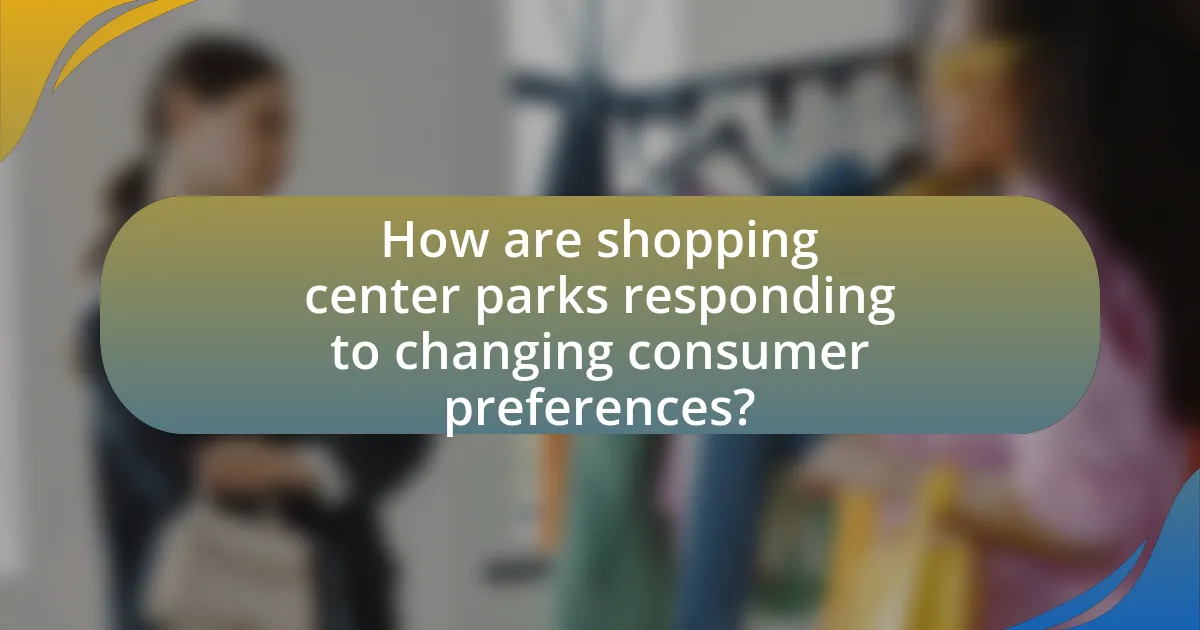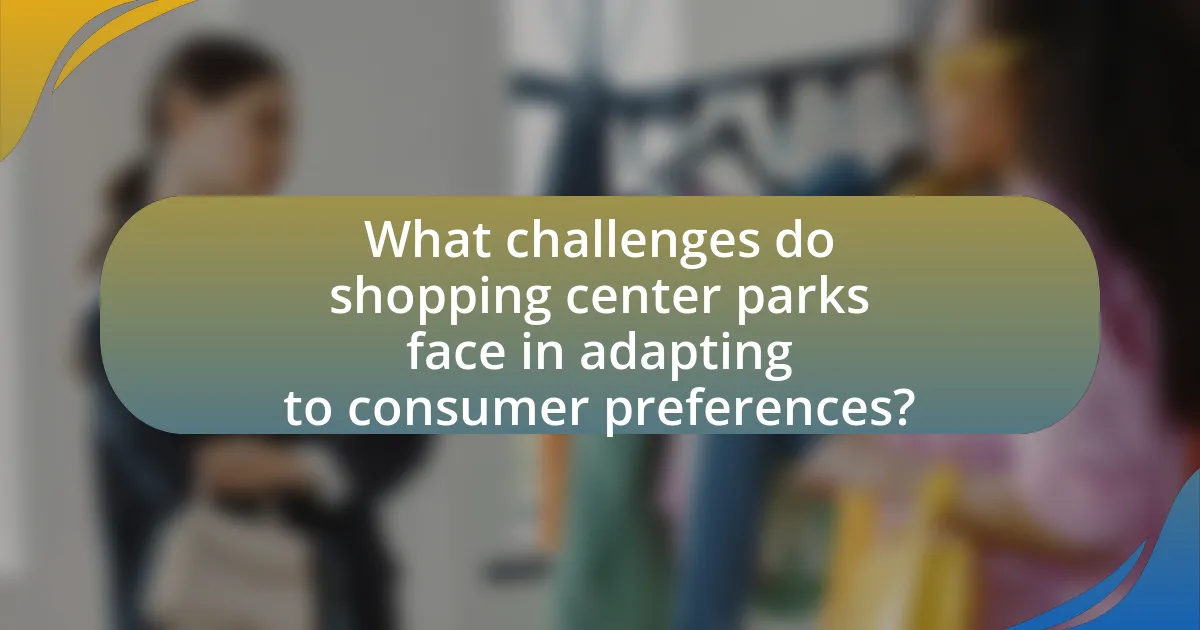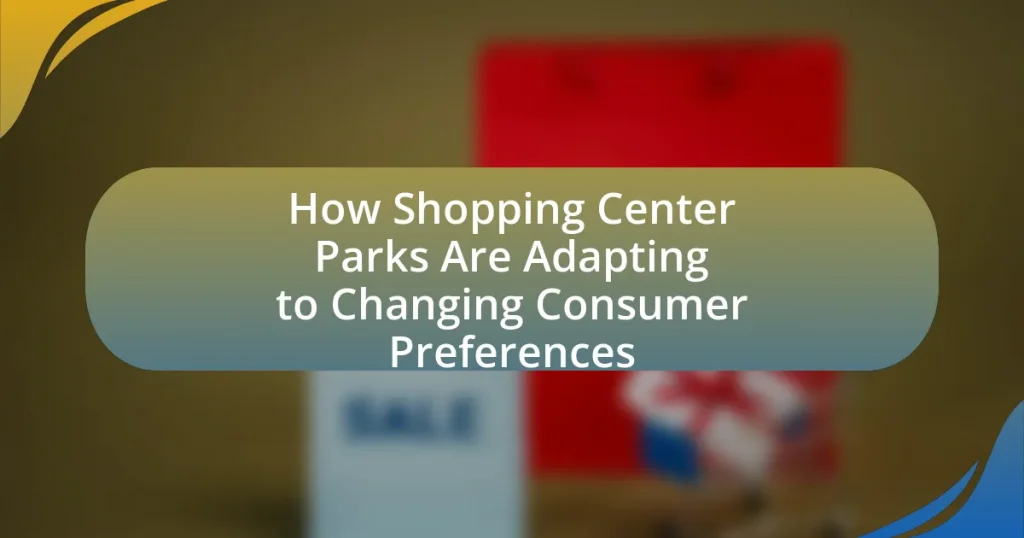Shopping center parks are evolving in response to changing consumer preferences by enhancing outdoor experiences and integrating mixed-use developments that combine retail, dining, and entertainment options. Key factors influencing these preferences include convenience, experiential offerings, and sustainability, with a significant shift towards eco-friendly practices. The rise of e-commerce has prompted shopping center parks to innovate by offering unique experiences and community-focused amenities to attract foot traffic. Additionally, demographic shifts and technological advancements are shaping the design and operation of these parks, emphasizing the importance of community engagement and feedback in enhancing consumer satisfaction.

How are shopping center parks responding to changing consumer preferences?
Shopping center parks are responding to changing consumer preferences by enhancing outdoor experiences and integrating mixed-use developments. These parks are increasingly incorporating green spaces, recreational areas, and community events to attract visitors seeking leisure and social interaction. For instance, many shopping center parks now feature outdoor seating, walking paths, and family-friendly activities, which cater to the growing demand for experiential retail environments. According to a 2022 report by the International Council of Shopping Centers, 70% of consumers prefer shopping destinations that offer a combination of retail, dining, and entertainment options, highlighting the shift towards a more holistic shopping experience.
What factors are influencing consumer preferences in shopping center parks?
Consumer preferences in shopping center parks are influenced by factors such as convenience, experiential offerings, and sustainability. Convenience is paramount, as consumers favor locations that provide easy access, ample parking, and a variety of services in close proximity. Experiential offerings, including entertainment options, dining experiences, and community events, attract consumers seeking more than just shopping. Additionally, sustainability practices, such as eco-friendly designs and local sourcing, resonate with environmentally conscious shoppers, driving their preference for certain shopping center parks. These factors collectively shape the shopping experience, aligning with modern consumer values and expectations.
How has the rise of e-commerce impacted consumer behavior in shopping center parks?
The rise of e-commerce has significantly altered consumer behavior in shopping center parks by shifting preferences towards online shopping, leading to decreased foot traffic in physical retail spaces. As consumers increasingly value convenience and the ability to compare prices online, many opt to shop from home rather than visit shopping centers. According to a report by the U.S. Department of Commerce, e-commerce sales accounted for 14.3% of total retail sales in the second quarter of 2020, highlighting a growing trend that impacts traditional shopping venues. This shift has prompted shopping center parks to adapt by enhancing their experiential offerings, such as entertainment and dining options, to attract consumers who seek more than just shopping.
What role does sustainability play in consumer preferences for shopping center parks?
Sustainability significantly influences consumer preferences for shopping center parks by aligning with the growing demand for environmentally responsible practices. Consumers increasingly prioritize shopping venues that incorporate green spaces, energy-efficient designs, and sustainable materials, reflecting a broader societal shift towards eco-consciousness. Research indicates that 70% of consumers are more likely to visit shopping centers that demonstrate a commitment to sustainability, such as using renewable energy sources and promoting biodiversity through landscaping. This trend underscores the importance of sustainability in attracting and retaining customers, as it enhances the overall shopping experience while addressing environmental concerns.
How are shopping center parks evolving to meet these preferences?
Shopping center parks are evolving by integrating more green spaces, recreational areas, and community-focused amenities to align with consumer preferences for outdoor experiences and social interaction. This evolution includes the addition of features such as walking trails, picnic areas, and event spaces that encourage community engagement. For instance, a study by the International Council of Shopping Centers found that 70% of consumers prefer shopping environments that offer outdoor spaces for relaxation and socializing. Additionally, shopping centers are incorporating sustainable landscaping and eco-friendly designs, which appeal to environmentally conscious consumers. This shift not only enhances the shopping experience but also attracts a diverse demographic seeking leisure and community connection.
What new amenities are being introduced in shopping center parks?
Shopping center parks are introducing amenities such as outdoor seating areas, enhanced landscaping, interactive play zones, and community event spaces. These features cater to the growing consumer preference for experiential shopping environments that promote social interaction and leisure. For instance, many shopping centers are incorporating green spaces and picnic areas to encourage families to spend more time on-site, reflecting a trend towards creating inviting atmospheres that blend retail with recreation.
How are shopping center parks enhancing the overall shopping experience?
Shopping center parks enhance the overall shopping experience by providing a multifunctional space that combines retail, leisure, and social interaction. These parks create an inviting atmosphere where shoppers can relax, socialize, and enjoy outdoor activities, which encourages longer visits and increased foot traffic. Research indicates that shopping centers with integrated parks see a 20% increase in customer dwell time, leading to higher sales per visit. Additionally, the presence of green spaces has been shown to improve customer satisfaction and well-being, making the shopping experience more enjoyable and appealing.

What trends are shaping the future of shopping center parks?
The future of shopping center parks is being shaped by trends such as the integration of experiential retail, sustainability initiatives, and the incorporation of technology. Experiential retail focuses on creating engaging environments that offer unique experiences beyond traditional shopping, such as entertainment and dining options, which cater to evolving consumer preferences for social interaction and leisure. Sustainability initiatives are increasingly important, with shopping centers adopting eco-friendly practices, such as green building designs and renewable energy sources, to appeal to environmentally conscious consumers. Additionally, the incorporation of technology, including mobile apps for navigation and augmented reality experiences, enhances customer engagement and convenience, reflecting the growing reliance on digital solutions in retail. These trends collectively indicate a shift towards creating multifunctional spaces that prioritize consumer experience and environmental responsibility.
How is technology influencing the design and operation of shopping center parks?
Technology is significantly influencing the design and operation of shopping center parks by integrating smart systems and enhancing customer experiences. For instance, the use of mobile apps allows visitors to navigate parks, find promotions, and access real-time information about events and services. Additionally, data analytics is employed to understand consumer behavior, enabling park operators to tailor offerings and optimize layouts based on foot traffic patterns. Smart lighting and energy-efficient systems are also being implemented to reduce operational costs and improve sustainability. These advancements not only enhance the shopping experience but also increase operational efficiency, as evidenced by a report from the International Council of Shopping Centers, which highlights that technology adoption can lead to a 20% increase in customer engagement.
What digital tools are being utilized to enhance consumer engagement in shopping center parks?
Digital tools such as mobile apps, interactive kiosks, and augmented reality experiences are being utilized to enhance consumer engagement in shopping center parks. Mobile apps provide personalized promotions and event notifications, while interactive kiosks offer information and wayfinding assistance. Augmented reality experiences create immersive interactions, allowing consumers to engage with the environment in innovative ways. These tools have been shown to increase foot traffic and consumer satisfaction, as evidenced by studies indicating that shopping centers employing such technologies see a significant rise in visitor engagement and dwell time.
How are shopping center parks integrating mobile apps and online platforms?
Shopping center parks are integrating mobile apps and online platforms by offering features such as digital maps, event notifications, and loyalty programs. These integrations enhance the consumer experience by providing real-time information about store promotions, events, and amenities, which aligns with the increasing demand for convenience and personalization in shopping. For instance, a study by the International Council of Shopping Centers found that 70% of consumers prefer to receive promotions via mobile apps, indicating a strong consumer preference for digital engagement. Additionally, many shopping center parks are utilizing online platforms for e-commerce capabilities, allowing customers to shop online and pick up items in-store, further bridging the gap between physical and digital shopping experiences.
What demographic shifts are affecting shopping center park designs?
Demographic shifts such as urbanization, an aging population, and increasing diversity are significantly affecting shopping center park designs. Urbanization has led to a higher concentration of consumers in city areas, prompting shopping centers to incorporate green spaces that cater to community gatherings and recreational activities. The aging population demands accessible designs with comfortable seating and walking paths, while increasing diversity necessitates inclusive spaces that reflect various cultural preferences and activities. These trends are supported by studies indicating that well-designed parks in shopping centers enhance foot traffic and customer satisfaction, ultimately driving sales.
How are shopping center parks catering to younger generations?
Shopping center parks are catering to younger generations by incorporating experiential retail, social spaces, and sustainable practices. These parks are designed to create engaging environments that encourage social interaction and community involvement, which are highly valued by younger consumers. For instance, many shopping center parks now feature outdoor seating areas, event spaces for live music or food festivals, and interactive installations that attract younger visitors. Additionally, a focus on sustainability, such as green spaces and eco-friendly design, resonates with the values of younger generations who prioritize environmental responsibility. According to a 2022 report by the International Council of Shopping Centers, 70% of millennials prefer shopping destinations that offer unique experiences and community-oriented activities, highlighting the effectiveness of these adaptations in meeting the preferences of younger consumers.
What changes are being made to accommodate families and diverse communities?
Shopping center parks are implementing various changes to accommodate families and diverse communities by enhancing accessibility, creating inclusive spaces, and offering family-oriented amenities. These changes include the installation of accessible pathways, family restrooms, and playgrounds designed for children of all abilities. Additionally, shopping centers are incorporating cultural events and programming that reflect the diversity of the community, such as multicultural festivals and workshops. These adaptations are supported by studies showing that inclusive environments increase community engagement and customer satisfaction, ultimately driving foot traffic and sales in shopping centers.

What challenges do shopping center parks face in adapting to consumer preferences?
Shopping center parks face significant challenges in adapting to consumer preferences, primarily due to shifting shopping habits and the rise of e-commerce. As consumers increasingly favor online shopping for convenience, shopping center parks must innovate to attract foot traffic. This includes enhancing the in-person experience through unique events, entertainment options, and improved amenities. Additionally, the demand for sustainability and eco-friendly practices is growing, requiring shopping center parks to invest in green technologies and sustainable designs to meet consumer expectations. According to a 2022 report by the International Council of Shopping Centers, 70% of consumers prefer shopping environments that prioritize sustainability, highlighting the necessity for shopping center parks to align with these preferences to remain competitive.
How are economic factors impacting the evolution of shopping center parks?
Economic factors are significantly influencing the evolution of shopping center parks by driving changes in consumer spending habits and retail strategies. For instance, the rise of e-commerce has led to a decline in traditional retail sales, prompting shopping center parks to diversify their offerings by incorporating experiential services such as entertainment, dining, and fitness options to attract foot traffic. According to a report by the International Council of Shopping Centers, 70% of consumers prefer shopping centers that provide a mix of retail and leisure activities, highlighting the necessity for shopping center parks to adapt to these economic shifts. Additionally, economic downturns can lead to increased vacancy rates, forcing property owners to rethink their leasing strategies and tenant mix to ensure sustainability and profitability.
What financial strategies are shopping center parks employing to remain competitive?
Shopping center parks are employing diversified revenue streams and enhanced tenant mix as financial strategies to remain competitive. By incorporating a blend of retail, dining, entertainment, and experiential offerings, these centers attract a broader customer base and increase foot traffic. For instance, many shopping center parks are integrating community events and pop-up shops, which not only generate additional income but also foster customer engagement. According to a report by the International Council of Shopping Centers, properties that diversify their tenant mix see a 20% increase in overall sales compared to those with a traditional retail-only approach. This strategic adaptation allows shopping center parks to effectively respond to changing consumer preferences and maintain their market relevance.
How do changing real estate markets affect shopping center park developments?
Changing real estate markets significantly influence shopping center park developments by altering demand, investment strategies, and design priorities. For instance, when real estate markets experience growth, developers are more likely to invest in larger, mixed-use shopping center parks that incorporate residential, retail, and recreational spaces to attract consumers. Conversely, in a declining market, developers may focus on cost-effective designs and smaller footprints, prioritizing essential retail and services over luxury amenities. Historical data shows that during the 2008 financial crisis, many shopping centers adapted by reducing their size and focusing on essential services, reflecting the immediate impact of market conditions on development strategies.
What strategies can shopping center parks implement to successfully adapt?
Shopping center parks can successfully adapt by integrating mixed-use developments that combine retail, dining, and entertainment options. This strategy addresses changing consumer preferences for convenience and experience, as evidenced by a 2022 report from the International Council of Shopping Centers, which found that 70% of consumers prefer shopping environments that offer diverse activities. Additionally, enhancing outdoor spaces for community events and recreational activities can attract visitors, as studies show that 60% of consumers are more likely to visit shopping centers with appealing outdoor areas. Implementing technology, such as mobile apps for promotions and virtual shopping experiences, further aligns with the increasing demand for digital engagement, with 50% of shoppers indicating a preference for tech-enhanced shopping experiences.
How can shopping center parks leverage community feedback for improvement?
Shopping center parks can leverage community feedback for improvement by implementing structured feedback mechanisms such as surveys, focus groups, and social media engagement. These methods allow parks to gather specific insights on visitor preferences, needs, and experiences, which can directly inform enhancements in amenities, programming, and overall design. For instance, a study by the International Council of Shopping Centers found that 70% of consumers prefer shopping centers that actively seek and respond to customer feedback, indicating a strong correlation between community engagement and customer satisfaction. By analyzing this feedback, shopping center parks can make data-driven decisions that align with community desires, ultimately leading to increased foot traffic and enhanced visitor experiences.
What best practices can shopping center parks adopt to enhance consumer satisfaction?
Shopping center parks can enhance consumer satisfaction by implementing a variety of best practices, including improving accessibility, offering diverse recreational activities, and ensuring cleanliness and safety. Accessibility can be improved by providing ample parking, well-maintained pathways, and public transportation options, which studies show significantly increase visitor numbers and satisfaction levels. Diverse recreational activities, such as playgrounds, fitness areas, and event spaces, cater to different demographics and preferences, leading to higher engagement and repeat visits. Additionally, maintaining cleanliness and safety through regular maintenance and security presence fosters a welcoming environment, as research indicates that consumers are more likely to return to well-kept spaces.















